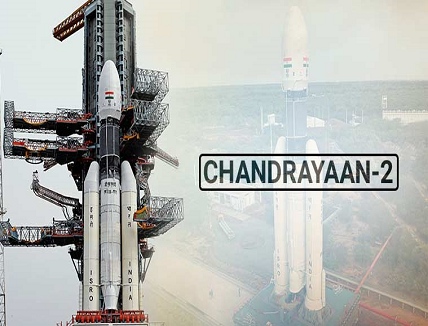
Chandrayaan-2 Orbiter’s 1st Observation – Argon Gas in Moon’s Atmosphere
Chandrayaan-2 has made its first observation of the global distribution of an inert, colourless and odorless element, Argon-40 gas in the lunar exosphere of the moon. According to the Indian Space Research Organisation (ISRO), this first-of-its-kind unique observation has been discovered by a quadrupole mass spectrometer “The Chandra’s Atmospheric Composition Explorer-2 (CHACE-2)”, onboard Chandrayaan-2 mission.
Bengaluru-headquartered space agency ISRO says that these observations provide insight on the radiogenic activities in the first few tens of metres below the lunar surface as well as dynamics of the lunar exospheric species and are very important.
Formation of Noble Gas Argon-40 in a lunar surface.
Exosphere is the most outermost region of the upper atmosphere where molecules and constituent atoms very rarely collide with each other and have a tendency to escape into space. To understand the surface-exosphere interaction, Noble Gas such as Argon-40 serves important role. But how it originates in the lunar surface?
Potassium-40 (K-40) is present below the lunar surface and when it breaks down due to radioactive disintegration gives origin to Argon-40. After its formation, it diffuses through the inter-granular space and makes way up to the lunar exosphere through seepages and faults.
Why these observations of Argon-40 important?
Noble gases play a very important role as they serve as the tracers to understand the surface-exosphere interaction processes. Noble gas Argon-40 (Ar-40) is an important tracer atom to study the dynamics of the lunar exospheric species and play a significant role in providing the insights of dynamics of the lunar exospheric species.
Uniqueness of this result from Chandrayaan-2 Chandra’s Atmospheric Composition Explorer-2 (CHACE-2) explained by the Space Agency.
Although Apollo-17 and LADEE missions have detected the presence of Ar-40 in the lunar exosphere but these measurements were only confined to near-equatorial region of the Moon. According to ISRO, the CHACE-2 observations have covered the equatorial and mid latitude regions of the Moon, providing the diurnal and spatial variation of Ar-40 and this is the uniqueness of the result from Chandrayaan-2 Spectrometer CHACE-2.

Studying the global dynamics of the lunar exospheric species is a temperature-driven process as there is a steep latitudinal temperature gradient of the lunar surface and it was so far a gap area to study the dynamics of the lunar exospheric species
In this context, the observations by Chandra’s Atmospheric Composition Explorer-2 (CHACE-2) onboard Chandrayaan-2 orbiter Argon-40 up to the mid-latitude regions (-60º to +60º) play a significant role to bridge the gap in the knowledge of the elements that are present on Moon.
What CHACE-2 observations revealed
CHACE-2 observations revealed the typical behaviour of a condensable gas showing an increase in the number density of Ar-40 near the sunrise terminator, which decrease through the dayside, a secondary peak near sunset terminator and a night-side minima.
Despite the differences in temperature and topography for the mid latitude regions, the CHACE-2 observations showed that the variation in the number density of Ar-40 with respect to solar longitudes are similar to that of low latitude regions.
In addition to this CHACE-2 observations also revealed that the distribution in Ar-40 has significant spatial heterogeneity. There are some localised enhancements which are termed as “Argon bulge” over several regions including the “KREEP” which is potassium (K) element and also some of the rare-earth elements with phosphorus (P) and South Pole Aitken terrain.
CHACE-2 observations of Argon bulge indicates the Moon quakes, regions with lower activation energies and unknown or additional loss processes, which call for a better understanding of the surface-exosphere interactions and source distributions of Argon-40 gas.
About The Chandra’s Atmospheric Composition Explorer-2 (CHACE-2)
CHACE-2 is a sequel of Chandrayaan-1 mission CHACE experiment on the Moon Impact Probe (MIP) and also draws heritage from the Mars Exospheric Neutral Composition Analyser (MENCA) experiment aboard the Indian Mars Orbiter Mission.


















